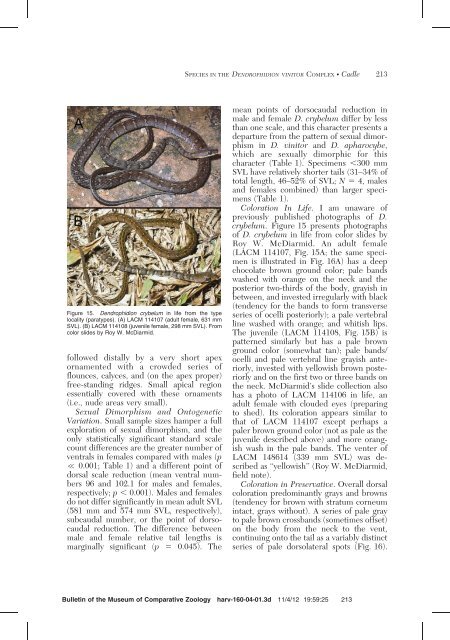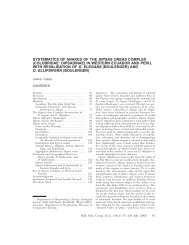cryptic species within the dendrophidion vinitor complex in middle ...
cryptic species within the dendrophidion vinitor complex in middle ...
cryptic species within the dendrophidion vinitor complex in middle ...
You also want an ePaper? Increase the reach of your titles
YUMPU automatically turns print PDFs into web optimized ePapers that Google loves.
SPECIES IN THE DENDROPHIDION VINITOR COMPLEX N Cadle 213<br />
Figure 15. Dendrophidion crybelum <strong>in</strong> life from <strong>the</strong> type<br />
locality (paratypes). (A) LACM 114107 (adult female, 631 mm<br />
SVL). (B) LACM 114108 (juvenile female, 298 mm SVL). From<br />
color slides by Roy W. McDiarmid.<br />
followed distally by a very short apex<br />
ornamented with a crowded series of<br />
flounces, calyces, and (on <strong>the</strong> apex proper)<br />
free-stand<strong>in</strong>g ridges. Small apical region<br />
essentially covered with <strong>the</strong>se ornaments<br />
(i.e., nude areas very small).<br />
Sexual Dimorphism and Ontogenetic<br />
Variation. Small sample sizes hamper a full<br />
exploration of sexual dimorphism, and <strong>the</strong><br />
only statistically significant standard scale<br />
count differences are <strong>the</strong> greater number of<br />
ventrals <strong>in</strong> females compared with males (p<br />
% 0.001; Table 1) and a different po<strong>in</strong>t of<br />
dorsal scale reduction (mean ventral numbers<br />
96 and 102.1 for males and females,<br />
respectively; p , 0.001). Males and females<br />
do not differ significantly <strong>in</strong> mean adult SVL<br />
(581 mm and 574 mm SVL, respectively),<br />
subcaudal number, or <strong>the</strong> po<strong>in</strong>t of dorsocaudal<br />
reduction. The difference between<br />
male and female relative tail lengths is<br />
marg<strong>in</strong>ally significant (p 5 0.045). The<br />
mean po<strong>in</strong>ts of dorsocaudal reduction <strong>in</strong><br />
male and female D. crybelum differ by less<br />
than one scale, and this character presents a<br />
departure from <strong>the</strong> pattern of sexual dimorphism<br />
<strong>in</strong> D. <strong>v<strong>in</strong>itor</strong> and D. apharocybe,<br />
which are sexually dimorphic for this<br />
character (Table 1). Specimens ,300 mm<br />
SVL have relatively shorter tails (31–34% of<br />
total length, 46–52% of SVL; N 5 4, males<br />
and females comb<strong>in</strong>ed) than larger specimens<br />
(Table 1).<br />
Coloration In Life. I am unaware of<br />
previously published photographs of D.<br />
crybelum. Figure 15 presents photographs<br />
of D. crybelum <strong>in</strong> life from color slides by<br />
Roy W. McDiarmid. An adult female<br />
(LACM 114107, Fig. 15A; <strong>the</strong> same specimen<br />
is illustrated <strong>in</strong> Fig. 16A) has a deep<br />
chocolate brown ground color; pale bands<br />
washed with orange on <strong>the</strong> neck and <strong>the</strong><br />
posterior two-thirds of <strong>the</strong> body, grayish <strong>in</strong><br />
between, and <strong>in</strong>vested irregularly with black<br />
(tendency for <strong>the</strong> bands to form transverse<br />
series of ocelli posteriorly); a pale vertebral<br />
l<strong>in</strong>e washed with orange; and whitish lips.<br />
The juvenile (LACM 114108, Fig. 15B) is<br />
patterned similarly but has a pale brown<br />
ground color (somewhat tan); pale bands/<br />
ocelli and pale vertebral l<strong>in</strong>e grayish anteriorly,<br />
<strong>in</strong>vested with yellowish brown posteriorly<br />
and on <strong>the</strong> first two or three bands on<br />
<strong>the</strong> neck. McDiarmid’s slide collection also<br />
has a photo of LACM 114106 <strong>in</strong> life, an<br />
adult female with clouded eyes (prepar<strong>in</strong>g<br />
to shed). Its coloration appears similar to<br />
that of LACM 114107 except perhaps a<br />
paler brown ground color (not as pale as <strong>the</strong><br />
juvenile described above) and more orangish<br />
wash <strong>in</strong> <strong>the</strong> pale bands. The venter of<br />
LACM 148614 (339 mm SVL) was described<br />
as ‘‘yellowish’’ (Roy W. McDiarmid,<br />
field note).<br />
Coloration <strong>in</strong> Preservative. Overall dorsal<br />
coloration predom<strong>in</strong>antly grays and browns<br />
(tendency for brown with stratum corneum<br />
<strong>in</strong>tact, grays without). A series of pale gray<br />
to pale brown crossbands (sometimes offset)<br />
on <strong>the</strong> body from <strong>the</strong> neck to <strong>the</strong> vent,<br />
cont<strong>in</strong>u<strong>in</strong>g onto <strong>the</strong> tail as a variably dist<strong>in</strong>ct<br />
series of pale dorsolateral spots (Fig. 16).<br />
Bullet<strong>in</strong> of <strong>the</strong> Museum of Comparative Zoology harv-160-04-01.3d 11/4/12 19:59:25 213







